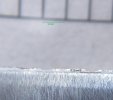BluntCut MetalWorks
Knifemaker / Craftsman / Service Provider
- Joined
- Apr 28, 2012
- Messages
- 3,462
I seek high strength + high toughness (together, not either or) for fully hardened(martensite matrix) steels.
3.5" blade, 0.095" spine thickness (near handle), FFG, distal taper, 14-15dps (28-30 degrees inclusive), 0.01" behind edge thickness, hardness 63rc
Satin Burl with Ebony handle.
Thanks for watching & comments.
Whittled: oak, pork rib bone, gabon ebony, lignum vitae arg, aluminum rod, hardened mild steel rod.
http://youtu.be/pr5ocZ9RUsM
Heheh - it sure wasn't easy to whittle hardened steel rod. The biggest microchip is around 0.12mm / 0.0048" deep. Hence thickness at damaged shoulder ~ 0.0028" / 0.07mm.

3.5" blade, 0.095" spine thickness (near handle), FFG, distal taper, 14-15dps (28-30 degrees inclusive), 0.01" behind edge thickness, hardness 63rc
Satin Burl with Ebony handle.
Thanks for watching & comments.
Whittled: oak, pork rib bone, gabon ebony, lignum vitae arg, aluminum rod, hardened mild steel rod.
http://youtu.be/pr5ocZ9RUsM
Heheh - it sure wasn't easy to whittle hardened steel rod. The biggest microchip is around 0.12mm / 0.0048" deep. Hence thickness at damaged shoulder ~ 0.0028" / 0.07mm.

Last edited:


